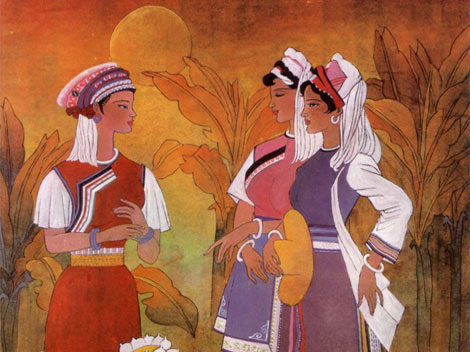In China, there are 1.594,827 people of the Bai nationality Most of them reside around the Ehai Lake in the Dili Bai Autonomous Prefecture in the west of Yunnan Province. The rest live elsewhere in Sichuan, Guizhou and Hunan provinces.

.jpg)
Bai women.
At the foot of the snowcapped Cangshan Mountain and by the clear blue Ehai Lake is the world famous Dali City where the Bais have long inhabited.
.jpg)
The gate tower forms an important pari of the Bais' residence.
.jpg)
The Third Month Street Fair is the principal festival of the Bais
.jpg)
The dowry.
The Bai areas enjoy prosperous economy and high civilization. Stable Bai communities have come into being from time immemorial. In the Han and Jin dynasties, the Bais' ances?tors were called "Kunming". The Tang government called them "Heman", Songwaiman" or "Baiman", while in the Yuan and Ming dynasties, they were known as the Bos. The Bai people showed special interests in white color. Hence, the name of Bai Nationality was generally accepted by them after the founding of new China.
The Bai language belongs to the Tibeto-Burman group of the Sino-Tibetan family. Most Bai people speak Chinese, through which they communicate with other nationalities.
.jpg)
The padauk furmiture.
As an ancient ethnic group, the Bais are proud of then- splendid civilization. In old days, Bai scholars were pioneers in astronomy, meteorology, medicine, painting and literature, and left a wealth of valuable cultural treasures such as the three pagodas in Chongsheng Temple of Dali, grottoes in Shibao Mountain of Jianchuan. The picture roll of the history of Nanzhao Zhongxing Kingdom and the picture roll of Dali.
.jpg)
A Bai bride in her rich phoenix headdress.
The Bais have long been an agricultural people. They oil the earth and fish as well. Today, the Bai area has been developed into a major grain and fish producer in the southwest border region.